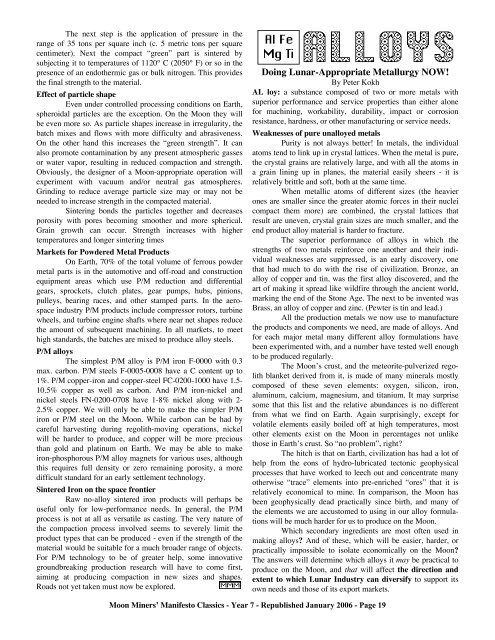MMM Classics Year 7: MMM #s 61-70
MMM Classics Year 7: MMM #s 61-70
MMM Classics Year 7: MMM #s 61-70
- No tags were found...
You also want an ePaper? Increase the reach of your titles
YUMPU automatically turns print PDFs into web optimized ePapers that Google loves.
The next step is the application of pressure in therange of 35 tons per square inch (c. 5 metric tons per squarecentimeter). Next the compact “green” part is sintered bysubjecting it to temperatures of 1120° C (2050° F) or so in thepresence of an endothermic gas or bulk nitrogen. This providesthe final strength to the material.Effect of particle shapeEven under controlled processing conditions on Earth,spheroidal particles are the exception. On the Moon they willbe even more so. As particle shapes increase in irregularity, thebatch mixes and flows with more difficulty and abrasiveness.On the other hand this increases the “green strength”. It canalso promote contamination by any present atmospheric gassesor water vapor, resulting in reduced compaction and strength.Obviously, the designer of a Moon-appropriate operation willexperiment with vacuum and/or neutral gas atmospheres.Grinding to reduce average particle size may or may not beneeded to increase strength in the compacted material.Sintering bonds the particles together and decreasesporosity with pores becoming smoother and more spherical.Grain growth can occur. Strength increases with highertemperatures and longer sintering timesMarkets for Powdered Metal ProductsOn Earth, <strong>70</strong>% of the total volume of ferrous powdermetal parts is in the automotive and off-road and constructionequipment areas which use P/M reduction and differentialgears, sprockets, clutch plates, gear pumps, hubs, pinions,pulleys, bearing races, and other stamped parts. In the aerospaceindustry P/M products include compressor rotors, turbinewheels, and turbine engine shafts where near net shapes reducethe amount of subsequent machining. In all markets, to meethigh standards, the batches are mixed to produce alloy steels.P/M alloysThe simplest P/M alloy is P/M iron F-0000 with 0.3max. carbon. P/M steels F-0005-0008 have a C content up to1%. P/M copper-iron and copper-steel FC-0200-1000 have 1.5-10.5% copper as well as carbon. And P/M iron-nickel andnickel steels FN-0200-0<strong>70</strong>8 have 1-8% nickel along with 2-2.5% copper. We will only be able to make the simpler P/Miron or P/M steel on the Moon. While carbon can be had bycareful harvesting during regolith-moving operations, nickelwill be harder to produce, and copper will be more preciousthan gold and platinum on Earth. We may be able to makeiron-phosphorous P/M alloy magnets for various uses, althoughthis requires full density or zero remaining porosity, a moredifficult standard for an early settlement technology.Sintered Iron on the space frontierRaw no-alloy sintered iron products will perhaps beuseful only for low-performance needs. In general, the P/Mprocess is not at all as versatile as casting. The very nature ofthe compaction process involved seems to severely limit theproduct types that can be produced - even if the strength of thematerial would be suitable for a much broader range of objects.For P/M technology to be of greater help, some innovativegroundbreaking production research will have to come first,aiming at producing compaction in new sizes and shapes.Roads not yet taken must now be explored.Doing Lunar-Appropriate Metallurgy NOW!By Peter KokhAL loy: a substance composed of two or more metals withsuperior performance and service properties than either alonefor machining, workability, durability, impact or corrosionresistance, hardness, or other manufacturing or service needs.Weaknesses of pure unalloyed metalsPurity is not always better! In metals, the individualatoms tend to link up in crystal lattices. When the metal is pure,the crystal grains are relatively large, and with all the atoms ina grain lining up in planes, the material easily sheers - it isrelatively brittle and soft, both at the same time.When metallic atoms of different sizes (the heavierones are smaller since the greater atomic forces in their nucleicompact them more) are combined, the crystal lattices thatresult are uneven, crystal grain sizes are much smaller, and theend product alloy material is harder to fracture.The superior performance of alloys in which thestrengths of two metals reinforce one another and their individualweaknesses are suppressed, is an early discovery, onethat had much to do with the rise of civilization. Bronze, analloy of copper and tin, was the first alloy discovered, and theart of making it spread like wildfire through the ancient world,marking the end of the Stone Age. The next to be invented wasBrass, an alloy of copper and zinc. (Pewter is tin and lead.)All the production metals we now use to manufacturethe products and components we need, are made of alloys. Andfor each major metal many different alloy formulations havebeen experimented with, and a number have tested well enoughto be produced regularly.The Moon’s crust, and the meteorite-pulverized regolithblanket derived from it, is made of many minerals mostlycomposed of these seven elements: oxygen, silicon, iron,aluminum, calcium, magnesium, and titanium. It may surprisesome that this list and the relative abundances is no differentfrom what we find on Earth. Again surprisingly, except forvolatile elements easily boiled off at high temperatures, mostother elements exist on the Moon in percentages not unlikethose in Earth’s crust. So “no problem”, right?The hitch is that on Earth, civilization has had a lot ofhelp from the eons of hydro-lubricated tectonic geophysicalprocesses that have worked to leech out and concentrate manyotherwise “trace” elements into pre-enriched “ores” that it isrelatively economical to mine. In comparison, the Moon hasbeen geophysically dead practically since birth, and many ofthe elements we are accustomed to using in our alloy formulationswill be much harder for us to produce on the Moon.Which secondary ingredients are most often used inmaking alloys? And of these, which will be easier, harder, orpractically impossible to isolate economically on the Moon?The answers will determine which alloys it may be practical toproduce on the Moon, and that will affect the direction andextent to which Lunar Industry can diversify to support itsown needs and those of its export markets.Moon Miners’ Manifesto <strong>Classics</strong> - <strong>Year</strong> 7 - Republished January 2006 - Page 19















